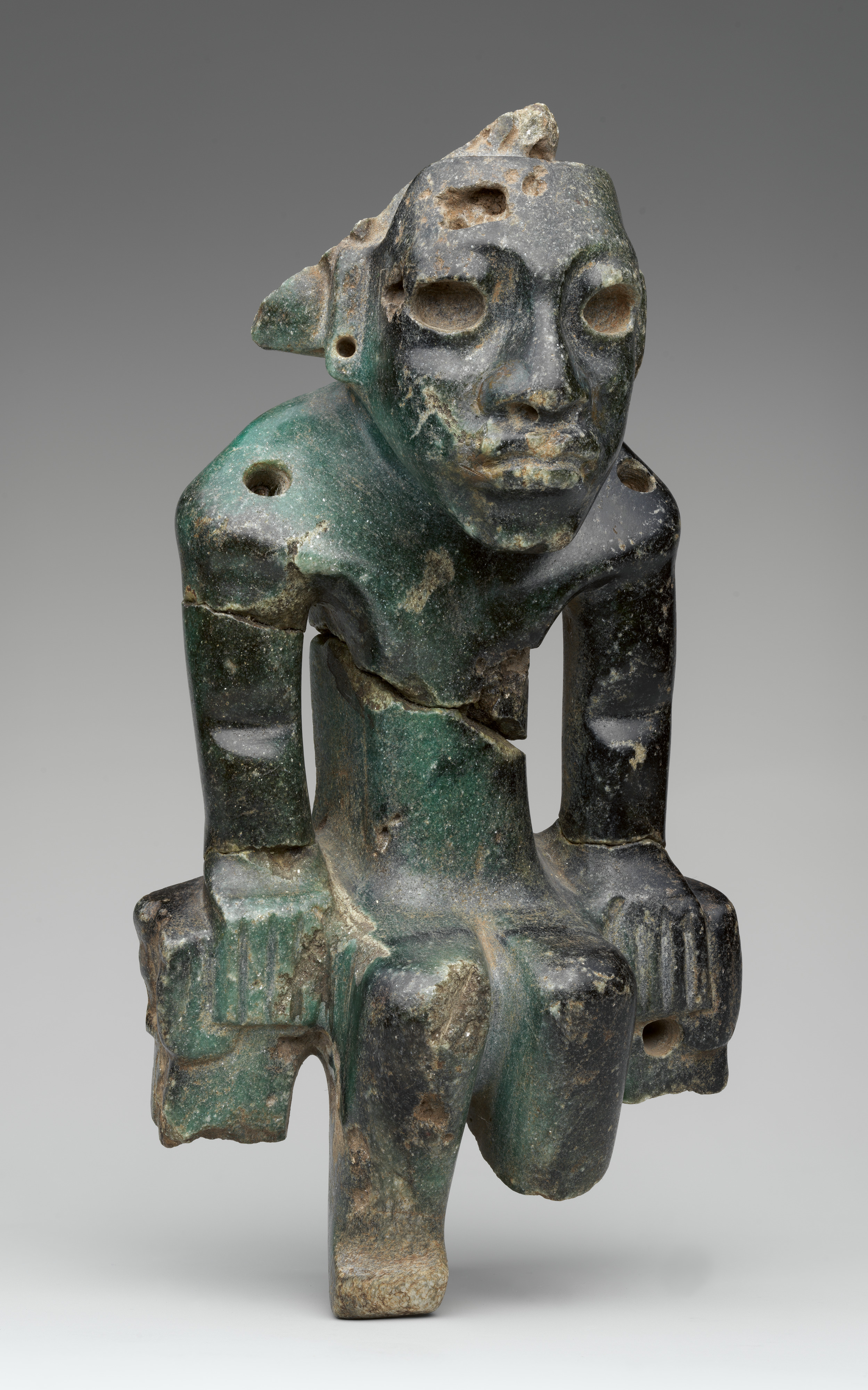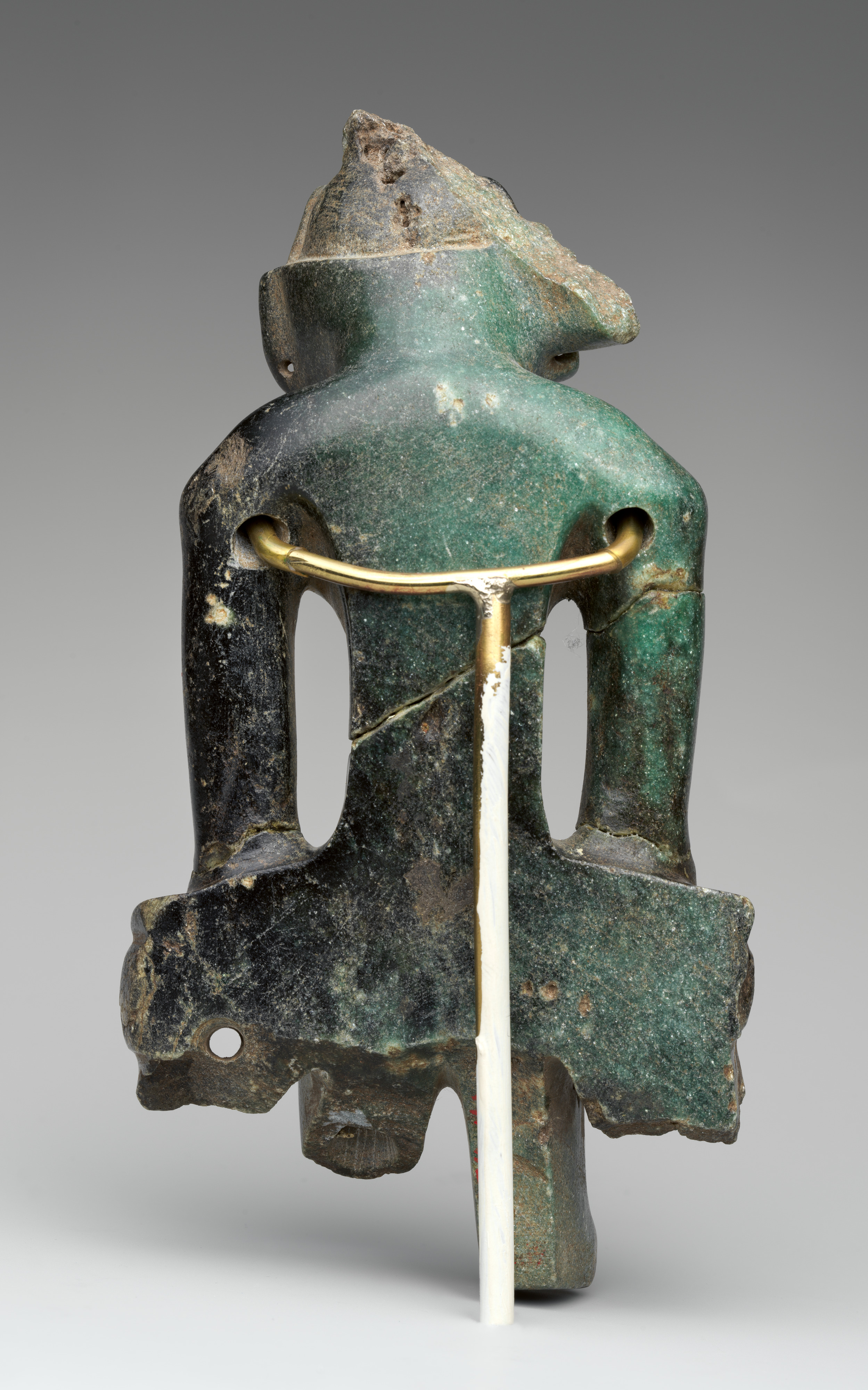Bench Figure
Not on view
A stylized figure sits on a bench gazing forward in this small-scale greenstone sculpture. The individual depicted has stylized proportions and elongated features, though largely displaying human attributes. The sculptor carefully contoured the face of the individual with a stolid expression, deeply drilling the eyes for the addition of probable inlays of other precious material like shell or obsidian. The squared ears also contain small drill holes for the addition of beads or other adornments. The arms, separated from the body by linear drill holes, display subtle musculature and terminate in blocky hands that rest on the bench to the side of either leg. Drilled holes through each shoulder may have once served to attach other perishable elements such as a cloak or other garment, and other holes in the throne might have served the same function.
The sculpture suffered considerable damage in the past, including to the rear of the face, which may have removed a headdress or other costume element, along with the legs of the throne and the figure’s left foot. Bench figures like this are known from highland central and southern Mexico and Guatemala, and have antecedents in earlier stone sculpture of the Olmec Gulf Coast, where monumentally scaled “altars” or thrones are thought to have served as the literal seats of power for rulers.
Further reading
Benson, Elizabeth P., and Beatriz de la Fuente, eds. Olmec Art of Ancient Mexico. Washington, D.C.: National Gallery of Art, 1996.
Berrin, Kathleen, and Virginia M. Fields, eds. Olmec: Colossal Masterworks of Ancient Mexico. San Francisco: Fine Arts Museums of San Francisco, 2010.
Cheetham, David, and Jeffrey P. Blomster, eds. The Early Olmec and Mesoamerica: The Material Record. Cambridge: Cambridge University Press, 2017.
Clark, John E., and Michael Blake El origen de la civilización en Mesoamérica: Los Olmecas y Mokaya del Soconusco de Chiapas, Mexico. In El Preclásico o Formativo: Avances y perspectivas, Martha Carmona Macias, ed. Museo Nacional de Antropología, México City, 1989, pp. 385–403.
Clark, John E., and Michael Blake The Power of Prestige: Competitive Generosity and the Emergence of Rank Societies in Lowland Mesoamerica. In Factional Competition and Political Development in the New World, Elizabeth M. Brumfiel and John W. Fox, eds., Cambridge: Cambridge University Press, 1994, pp: 17– 30.
Coe, Michael D. The Jaguar’s Children: Pre-Classic Central Mexico. New York: Museum of Primitive Art, 1965.
Coe, Michael D. The Olmec Style and Its Distributions. In Handbook of Middle American Indians, vol. 3 (Robert Wauchope, gen. ed.). Austin: University of Texas Press, 1965, pp. 739–775
Coe, Michael D. (ed.) The Olmec World: Ritual and Rulership. Princeton: The Art Museum, Princeton University, 1996.
Coe, Michael D., and Richard A. Diehl 1980 In the Land of the Olmec: The Archaeology of San Lorenzo Tenochtitlán, 2 vols. Austin: University of Texas Press.
Covarrubias, Miguel Origen y desarrollo del estilo artístico “Olmeca.” In Mayas y Olmecas: Segunda reunión de Mesa Redonda sobre problemas antropológicos de México y Centro América. Mexico City: Talleres, 1942, pp. 46-49.
Cyphers Guillén, Ann From Stone to Symbols: Olmec Art in Social Context at San Lorenzo Tenochtitlán. In Social Patterns in Pre-Classic Mesoamerica (David C. Grove and Rosemary A. Joyce, eds.), Washington, D.C.: Dumbarton Oaks, 1999, pp. 155–181.
Drucker, Philip La Venta, Tabasco: A Study of Olmec Ceramics and Art. Smithsonian Institution, Bureau of American Ethnology, Bulletin 153. Washington, D.C.: Government Printing Office, 1952.
Drucker, Philip, Robert F. Heizer, And Robert J. Squier 1959 Excavations at La Venta, Tabasco, 1955. Smithsonian Institution, Bureau of American Ethnology, Bulletin 170. Washington, D.C.: Government Printing Office, 1959.
Easby, Elizabeth Kennedy, and John F. Scott Before Cortés: Sculpture of Middle America. New York: Metropolitan Museum of Art, 1970.
Feuchtwanger, Franz Ceramica olmeca. Mexico City: Editorial Patria, 1989.
Grove, David C. Olmec: What’s in a Name? In Regional Perspectives on the Olmec (Robert J. Sharer and David C. Grove, eds.): Cambridge: Cambridge University Press, 1989, pp. 8-14.
Joralemon, Peter David A Study of Olmec Iconography. Studies in Pre-Columbian Art and Archaeology 7. Washington, D.C.: Dumbarton Oaks, 1971.
Magaloni Kerpel, Diana, and Laura Filloy Nadal La Ofrende 4 de La Venta: un tesoro olmeca reunido en el Museo Nacional de Antropología. Mexico City: Instituto Nacional de Antropología e Historia, 2013.
Michelet, Dominique, Cora Falero Ruiz, and Steve Bourget Les Olmèques et les cultures du golfe du Mexique. Paris: Skira, 2020.
Pool, Christopher A. Olmec Archaeology and Early Mesoamerica. New York: Cambridge University Press, 2007.
Reilly, Frank Kent, III The Shaman in Transformation Pose: A Study of the Theme of Rulership in Olmec Art. Record of the Art Museum, Princeton University vol. 48 no. 2, 1989, pp. 4–21.
Taube, Karl A. Olmec Art at Dumbarton Oaks. Washington, D.C.: Dumbarton Oaks, 2004.
Due to rights restrictions, this image cannot be enlarged, viewed at full screen, or downloaded.
This artwork is meant to be viewed from right to left. Scroll left to view more.




